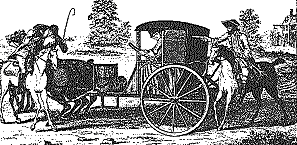The Highwaymen of Hounslow Heath
 Once part of the extensive Forest of Middlesex, and now largely buried beneath the runways of London Airport, Hounslow Heath was for more than 200 years the most dangerous place in Britain. Between the 17th and early 19th centuries, the Heath occupied perhaps 25 square miles. No one was really certain where its boundaries lay, and no one cared, for it was a tract of country to be crossed as quickly as possible. Though Hounslow itself was not large, it was after London the most important of coaching centres. Across the Heath ran the Bath Road and the Exeter Road, along which travelled wealthy visitors to West Country resorts and courtiers travelling to Windsor. All provided rich pickings for highwaymen lurking in copses bordering the lonely ways. Once part of the extensive Forest of Middlesex, and now largely buried beneath the runways of London Airport, Hounslow Heath was for more than 200 years the most dangerous place in Britain. Between the 17th and early 19th centuries, the Heath occupied perhaps 25 square miles. No one was really certain where its boundaries lay, and no one cared, for it was a tract of country to be crossed as quickly as possible. Though Hounslow itself was not large, it was after London the most important of coaching centres. Across the Heath ran the Bath Road and the Exeter Road, along which travelled wealthy visitors to West Country resorts and courtiers travelling to Windsor. All provided rich pickings for highwaymen lurking in copses bordering the lonely ways.
The first of the legendary highwaymen were Royalist officers who "took to the road" when they were outlawed under the Commonwealth. These were men familiar with the relatively new-fangled pistols, which gave them an advantage over their victims, usually only armed with swords.
Perhaps because they concentrated on the wealthy, the highwaymen became popular heroes. No one, except the victims, grieved when the dukes of Northumberland and St Albans were held up on the Heath at the end of the 17th century. And when one audacious villain pasted notices on the doors of rich Londoners telling them they should not venture forth without less than a watch and 10 guineas, the whole town was convulsed with laughter.
Famous Highwaymen on the Heath
While many of the highwaymen were thugs pure and simple, it cannot be denied that some of them had a certain flair. There was Twysden, Bishop of Raphoe, who was shot and killed while carrying out a robbery on the Heath- though it was later given out that he had died of 'an inflammation'. Others returned money to needy victims, and released women and children unmolested, including the children of the Prince of Wales, held up at Hounslow in 1741. There are even accounts of robberies in which the victim is referred to as 'a man' and the robber as 'a gentleman'.
To be robbed by a famous highwayman was regarded as something of an honour. When James Maclaine accidentally wounded Horace Walpole while attempting to rob him, the antiquarian bore no grudge and wrote to tell him so. In June 1750, Maclaine also held up Lord Eglington, taking 50 guineas and his lordship's blunderbuss. Dick Turpin is credited with having stayed in most old pubs in the Hounslow area, but in fact he mostly confined his activities to Essex, North London and Yorkshire. The most gallant of the Heath's highwaymen was probably the French-born Claude Duval, who danced with a beautiful victim on the Heath and let her wealthy husband go for £100.
Despite the inefficiency of the authorities, few highwaymen survived beyond their early twenties. Betrayed for blood-money, or by their own carelessness, most of them ended their short lives on Tyburn Tree, where felons were hanged. Most died well, and when they were dead, their bodies were returned to the scene of their crimes, there to hang rotting as a lesson to others. So plentiful were the gibbets on Hounslow Heath, that they came to be regarded as landmarks, and even figured on 18th century maps.
|

